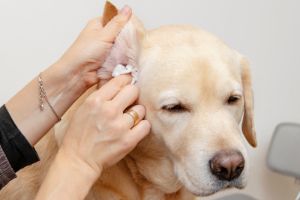Did you know yeast infections, NOT ear mites, are the primary cause of ear infections in dogs. Dogs just seem to get yeast infections in their ears, especially in our allergy laden South Texas environment. Most veterinarians can likely count the number of dogs with ear mites they’ve seen during their practice career on two hands. And because we’ve also seen many pet owners wait too long to obtain treatment for what can be painful or very uncomfortable ear infections, we’re sharing tips on how to know when it’s time to take your canine companion to the veterinarian.
How Do Dogs Get Ear Infections?
Dogs have very deep ear canals. Especially floppy-eared or hairy-eared dogs have reduced airflow leads to a warm, moist environment in the ear that encourages yeast growth.

How to Treat Canine Ear Infections
Because of the link to moisture, the treatment of most ear infections, is aimed at killing the yeast and making the environment of the ear less hospitable to yeast growth. We accomplish this by REPEATED application of a prescription and drying acidifying ear cleanser several times a week until the ear infection is cleared.
The steps to how veterinarians treat ear infections in dogs:
Step 1: Examine a swab of the infection under the microscope to determine if it’s a yeast infection, bacteria or a combination. (Rarely, there may also be ear mites)
Step 2: If a bacterial ear infection is suspected, and purulent debris is observed, send a sample to the lab for culture
Step 3: Clean the ear using a prescription veterinary ear cleaner
Step 4: Instill a small amount of prescription ear ointment or drops into the canal
Step 5: Repeat the above steps daily until the infection is resolved
Step 6: When you think the infection has passed, visit our veterinarian for a re-check exam to assure no remaining infection exists
Our veterinarian must take a swab of your dog’s ear discharge, look at it under the microscope, and perhaps even send a sample of it to the lab to be cultured for bacteria before we’re able to prescribe the right kind of ear medication for your particular dog’s particular infection. Is it just wax? Or yeast? Or bacteria sensitive to penicillin? Or bacteria resistant to cephalexin? Let our veterinarian perform a swab cytology to diagnose for sure. For example, what if allergies cause your dog’s ear infection? If you and our veterinarian don’t treat the dog's allergies, you’re just treating the tip of the iceberg.

How to Clean Your Dog’s Ears
Simply inspecting your dog’s ears regularly is the first step to being a responsible pet owner.
The inspection process for your dog’s ears should go as follows:
- If your dog has floppy ears, gently lift the ear flap to expose the inside of the ear.
- Try to hold your dog’s head in a position that will allow the cleaning solution to flow down into the ear canal.
- Visually examine the ear, and wipe away any loose dirt and residue from just inside the ear.
The cleaning process for your dog’s ears should go as follows:
- Squeeze ear cleaning solution into the ear, filling the ear canal. There cannot be too much.
- Put one finger in front of and at the base of the earflap, and put your thumb behind and at the base.
- Massage the ear canal between your finger and thumb. A squishing sound tells you that the medication has gone into the horizontal canal.
- Insert a cotton ball into the ear canal and soak up stinky brown ear wax-laden excess liquid from deep within the canal. .
- Repeat flushing as necessary, replacing saturated or soiled cotton balls with new ones until the ear is dry and clean.
- Wipe any residue from the inside of the ear flap.
- Discard all used cotton. Never re-use anything from one ear on the other.
Medicating Your Dog For Ear Infections
There’s not much to this section other than to say to follow the directions on the prescribed canine ear infection medication for both ears. Of course, giving your dog a hug and a healthy treat after giving the medication will always go a long way in making it an easier process as time goes on.
Take note! One of our veterinarian’s most frustrating phone calls is the owner who wants a refill of medicated ear ointment, yet says, “Oh, I have PLENTY of ear cleaner left at home!” Understand this: your dog has an ear infection again EITHER because of allergies (very common in South Texas), or because the ears have not been cleaned often enough to prevent recurrence of the infection. If you’re treating your dog's ear infections properly, you’re supposed to run out of ear cleaner BEFORE you run out of ointment because you’re cleaning the ears consistently, especially during allergy season.
How Often Should I Clean My Dog’s Ears?
For dogs with a history of recurrent ear problems, weekly cleaning may be necessary. Weekly ear inspections and prompt veterinary treatment at the first sign of infection are essential. We cannot emphasize enough that the treatment of most dogs' ear infections does NOT involve just a prescription ointment but, rather, ongoing maintenance of the healthy ear canal by the dog owner.
If you suspect an ear infection, call our veterinarian immediately. Please don’t wait until your dog is in pain or struggling with ears that won’t stop itching. Don’t rely on the internet or OTC products in the pet store wasting time with medications that won’t work—let the veterinarian treat your dog correctly the first time.
Think your canine companion may be suffering from an ear infection? Call us right away so we can get your dog pet back on the path to wellness.




